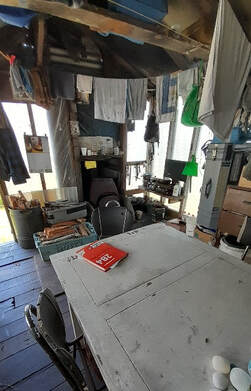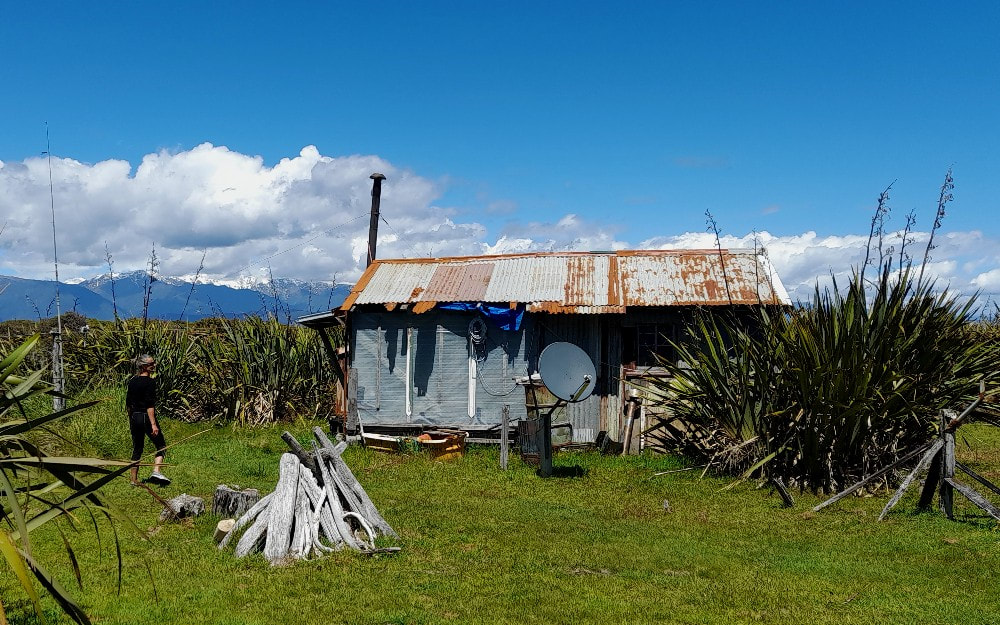Top Okarito Hut

Maintenance Status
Top Okarito Hut, a.k.a. Okarito Lagoon Hut, or Okarito Duck Shooters' Hut, is a maintain-by-community project with Bruce Reay of Haast as its signatory, and self-appointed caretaker. The Hut was privately built in the 1950's and DOC were keen on removing it. Bruce is renowned for his tenacity when it comes to dealing with bureaucracy, persevered, and eventually managed to get the Department on board. He got a 10-year contract to look after the place that is about to expire and is hoping there is enough good will to secure a renewal. Gavin Molloy of Franz Josef has said that he is keen to do a bit of renovation work on the old place to make it more liveable.
Location
Okarito catchment. Map BW16. GPS Ref: E1374239/ N5218190 (BW16 742 182). Altitude 0m. Top Okarito Hut is located on the sandspit at the top end of Okarito Lagoon, snuggled against the southern lee of Commissioner Point. The Hut is the furthest North of several informal dwellings on the Lagoon and is sited a few metres within the boundary of the Waitangiroto Nature Reserve (of white heron fame). Theoretically one requires a permit for entry under the Reserves Act but it is unlikely that Hut users will have to go through this process. The Hut is in a grassy clearing surrounded by gorse, bracken, and harakeke (flax). On inland side it's a wetland ecosystem, transitioning to dense coastal podocarp forest on the raised areas above the Lagoon. It's a beautiful spot with potential for beach bonfires and surfcasting when the sea is calm. The Hut currently gets 12-15 visits per year. There are photos in the Hut of boats tying up to it when the Lagoon outlet has blocked up and its waters have risen above floor level a few times.
Access
Top Okarito Hut can be reached by kayaking up the Lagoon from Okarito. Alternately, a short crossing can be made from the old wharf to the sand spit opposite town, and the remainder of the journey made on foot up the beach to the Hut. Both approaches take around two hours from Okarito village. Kayak access can be a lot slower if tide and wind conditions aren't favourable. On the rare occasions that the Lagoon dams up, 4WD access would be possible.
Top Okarito Hut, a.k.a. Okarito Lagoon Hut, or Okarito Duck Shooters' Hut, is a maintain-by-community project with Bruce Reay of Haast as its signatory, and self-appointed caretaker. The Hut was privately built in the 1950's and DOC were keen on removing it. Bruce is renowned for his tenacity when it comes to dealing with bureaucracy, persevered, and eventually managed to get the Department on board. He got a 10-year contract to look after the place that is about to expire and is hoping there is enough good will to secure a renewal. Gavin Molloy of Franz Josef has said that he is keen to do a bit of renovation work on the old place to make it more liveable.
Location
Okarito catchment. Map BW16. GPS Ref: E1374239/ N5218190 (BW16 742 182). Altitude 0m. Top Okarito Hut is located on the sandspit at the top end of Okarito Lagoon, snuggled against the southern lee of Commissioner Point. The Hut is the furthest North of several informal dwellings on the Lagoon and is sited a few metres within the boundary of the Waitangiroto Nature Reserve (of white heron fame). Theoretically one requires a permit for entry under the Reserves Act but it is unlikely that Hut users will have to go through this process. The Hut is in a grassy clearing surrounded by gorse, bracken, and harakeke (flax). On inland side it's a wetland ecosystem, transitioning to dense coastal podocarp forest on the raised areas above the Lagoon. It's a beautiful spot with potential for beach bonfires and surfcasting when the sea is calm. The Hut currently gets 12-15 visits per year. There are photos in the Hut of boats tying up to it when the Lagoon outlet has blocked up and its waters have risen above floor level a few times.
Access
Top Okarito Hut can be reached by kayaking up the Lagoon from Okarito. Alternately, a short crossing can be made from the old wharf to the sand spit opposite town, and the remainder of the journey made on foot up the beach to the Hut. Both approaches take around two hours from Okarito village. Kayak access can be a lot slower if tide and wind conditions aren't favourable. On the rare occasions that the Lagoon dams up, 4WD access would be possible.
 Hut interior
Hut interior
Type
Top Okarito Hut is one of the numerous basic, non-legal structures that appeared in various locations along the West Coast during the last century. The original structure, your basic corrugated iron shack with four bunks, was built sometime in the 1950's by persons unknown. A wooden framed, heavy-duty plastic cladded extension was added to the front end at some point, making the interior pleasantly light. The ancient firebox smokes a bit in easterly winds and although locals have brought in a new one, Bruce hasn't done anything with it yet. There are water tanks to collect drinking water. There is no toilet. According to Bruce this is the most historic hut on the Lagoon and the only one that is unlocked and open for public use. The remaining half dozen in the area while more palatial, are owned and locked. Top Okarito Hut is a veritable museum full of Bruce's junk, knickknacks and memorabilia and has quite a good library. He stores his gear there and visits around once yearly, usually April – May, "to sweep out the rat shit," and trim the gorse and bracken. As far as Bruce is concerned anyone may use it, provided they don’t interfere with his gear, don't burn it down, latch the door on departure, replace firewood, and sign the hutbook to give an indication of levels use and provide feedback. A mozzie net is recommended for overnighters.
Condition
Top Okarito Hut is pretty rickety by anybody's standards but despite this, is dry and quite homely. The external iron cladding and roof is a fine example of coastal corrosion in action. The framing and piles are original and probably wouldn't meet third world building standards and the floor in the bunkroom, a fascinating mosaic of salvaged material. The hut is rodent free currently thanks the ongoing predator control work of Bruce's nearest neighbour.
Routes
An old, benched miners track has been kept open over Commissioner Point, and a predator traplines leads to the picturesque Lake Okaritoiti. An old, bulldozed road over Waitahi Bluff to the Waitangiroto River has been kept open. The Lagoon itself provides plenty of kayaking opportunities.
Repairs needed.
Top Okarito would benefit most from being knocked down and built anew, however this probably isn't going to happen. One would need to know then whether DOC is happy or not to tolerate the hut's continued existence on this most sacred of sites. A considerable amount of general maintenance will need to be done at some point to keep it from inevitable dilapidation.
Provisions on site
Then hut is very well provisioned with billies, utensils, and a camp oven. There is an antique kerosene cooker that leaks according to the inscription on it. There is a fair bit of electrical wiring and plugs and lights of various sorts that would presumably work with a generator. Bruce has a lot of his gear stored there. Please don't interfere with or take any of it.
Top Okarito Hut is one of the numerous basic, non-legal structures that appeared in various locations along the West Coast during the last century. The original structure, your basic corrugated iron shack with four bunks, was built sometime in the 1950's by persons unknown. A wooden framed, heavy-duty plastic cladded extension was added to the front end at some point, making the interior pleasantly light. The ancient firebox smokes a bit in easterly winds and although locals have brought in a new one, Bruce hasn't done anything with it yet. There are water tanks to collect drinking water. There is no toilet. According to Bruce this is the most historic hut on the Lagoon and the only one that is unlocked and open for public use. The remaining half dozen in the area while more palatial, are owned and locked. Top Okarito Hut is a veritable museum full of Bruce's junk, knickknacks and memorabilia and has quite a good library. He stores his gear there and visits around once yearly, usually April – May, "to sweep out the rat shit," and trim the gorse and bracken. As far as Bruce is concerned anyone may use it, provided they don’t interfere with his gear, don't burn it down, latch the door on departure, replace firewood, and sign the hutbook to give an indication of levels use and provide feedback. A mozzie net is recommended for overnighters.
Condition
Top Okarito Hut is pretty rickety by anybody's standards but despite this, is dry and quite homely. The external iron cladding and roof is a fine example of coastal corrosion in action. The framing and piles are original and probably wouldn't meet third world building standards and the floor in the bunkroom, a fascinating mosaic of salvaged material. The hut is rodent free currently thanks the ongoing predator control work of Bruce's nearest neighbour.
Routes
An old, benched miners track has been kept open over Commissioner Point, and a predator traplines leads to the picturesque Lake Okaritoiti. An old, bulldozed road over Waitahi Bluff to the Waitangiroto River has been kept open. The Lagoon itself provides plenty of kayaking opportunities.
Repairs needed.
Top Okarito would benefit most from being knocked down and built anew, however this probably isn't going to happen. One would need to know then whether DOC is happy or not to tolerate the hut's continued existence on this most sacred of sites. A considerable amount of general maintenance will need to be done at some point to keep it from inevitable dilapidation.
Provisions on site
Then hut is very well provisioned with billies, utensils, and a camp oven. There is an antique kerosene cooker that leaks according to the inscription on it. There is a fair bit of electrical wiring and plugs and lights of various sorts that would presumably work with a generator. Bruce has a lot of his gear stored there. Please don't interfere with or take any of it.



